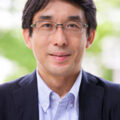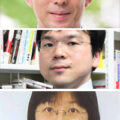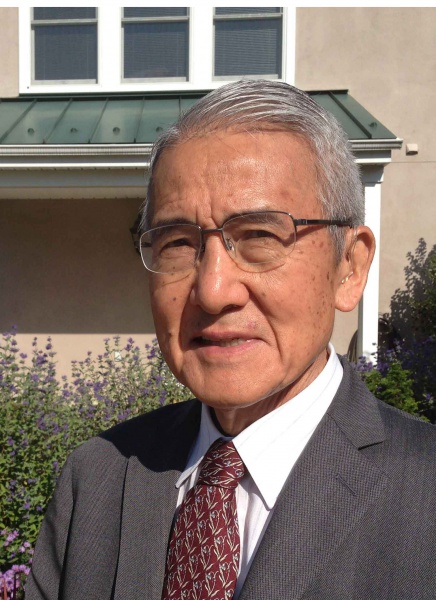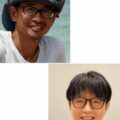Corporations and Geniuses― The main man behind the invention of blue LEDs speaks.Serendipity: No Such Thing Exists Interview with Amano Hiroshi, Professor, Graduate School of Engineering, Nagoya University
The invention of blue LEDs was the product of the conviction of a researcher who does not even view effort as really effort. How should corporations deal with capable researchers?

22 October 2014, Professor Amano visited the Prime Minister’s Office (From the website of the Prime Minister of Japan and his Cabinet)
The dream of all researchers is to make possible that which is considered to be impossible. They seek to conceive an invention that breaks accepted theories. However, the road to innovations that destroy paradigms is a long one, and they can only be brought about through years of research that goes unnoticed. This was the case of the research of Amano Hiroshi, a professor at Nagoya University who worked on inventing blue light-emitting diodes (LEDs).
In 1983, Professor Amano enrolled in a master’s program at Nagoya University. To produce gallium nitride crystal, a material for blue LEDs, he lit his device every day except New Year’s, and yet after more than 1,500 attempts he failed to produce it. However, one evening in winter two years later, he succeeded in creating the crystal right when he was about to give up.
Thirty years have passed since then. The culture that values basic research has gradually fallen away, while the number of Japanese students enrolled in master’s programs has also declined due to economic reasons and the difficulty in finding employment after graduation. How should young researchers approach their research, and how should industry apply their abilities?
You succeeded in growing gallium nitride crystal when you were 24 years old.
Professor Amano Hiroshi: Apart from days for academic meetings, I pretty much conducted experiments every day. I arrived at the laboratory between 10:30 and 11 in the morning, and after getting things ready, I would conduct three experiments a day on average, and five or six experiments when things were going well. But after conducting more than 1,500 experiments, I was still unable to create fine crystals. However, I did not feel a sense of failure.
Research was left to the initiative of the students. Professor Akasaki Isamu [who received the Nobel Prize together with Professor Amano] specified for MOBPE [a crystal growth method that uses organic metals and gases] to be used, and the rest was left up to the students to figure out. This means everything from processing quartz tubes for creating crystals to placing orders of parts.
Budgets for basic research from the university were not sufficiently adequate.
Amano: The budget situation was severe. I think it’s alright to say this now, but there was actually someone who supported our research. When Professor Akasaki was a worker at a company, he did research with Hashimoto Masafumi. Around the time when Professor Akasaki moved to Nagoya University, Hashimoto moved to another company in Nagoya. Hashimoto helped us continue our experiments in many different ways.
The support that we received from him was extremely valuable. Looking back now, I don’t think we would have been able to continue our experiments efficiently without his support.
Does it mean that your experiments gave rise to high expectations and attracted a lot of attention?
Amano: Actually, no one paid attention to our research. When Professor Akasaki was working for Matsushita, several organizations—including Hitachi, the University of Tokyo, RCA in the United States, and a research center of the Dutch corporation Phillips in France—were all tackling nitride crystal growth. However, they found the task to be far too difficult, and the United States withdrew from research, followed by France. Matsushita also suspended research.
In this midst of this environment, Nagoya University ultimately succeeded in creating fine crystals with excellent light-emitting characteristics. We happily took part in an academic meeting and presented this valuable report of our achievement. Yet, there were only four people who came for our presentation, two of whom were Professor Akasaki and I. That was very disappointing.
What they really wanted was to create laser diodes that required a higher level of technology than LEDs. For that, P-type gallium nitride [a semiconductor with holes through which electrons pass carrying an electric current] needed to be created.
In 1989, we created the p-type. At about the same time, Matsuoka Takashi of NTT [currently a professor at Tohoku University] successfully created blue light by replacing some of the gallium atoms with indium atoms.
The Nobel Prize is awarded to only three people in each category. If that wasn’t the case, it is believed Matsuoka would have also received an award.
Amano: Yes, Matsuoka. I think so, too. The breakthrough he achieved was significant. We were also experimenting using the same materials, but we couldn’t really produce precise results. But Matsuoka was able to.
The first time I heard about Matsuoka was at an academic meeting in 1989. The two breakthroughs happened to be announced at the same meeting. Both Matsuoka and I were shocked by each other’s work. However, even at this stage, almost no one was interested in the work we were doing. We were in a very difficult position.
It was Nakamura [Shuji] [of Nichia Corporation] who caught the attention of the media. In the 1990s, Nichia Corporation made a series of announcements about its significant achievements. We felt there was no way we could keep up, no matter how hard we tried. Nakamura’s announcements were superhuman and explosive. He presented them in a way completely different from the common structure for making announcements at academic meetings. He gave demonstrations, boasting of his single-handed achievements. I think Nakamura was the one who got the media to start paying attention to this technology.
However, I’ve never had any association with Nakamura. We probably read each other’s research papers, but we never met up to discuss issues.
The importance of having a future vision also applies to basic research.
In the mid-1980s, Japanese corporations allocated adequate-size budgets for basic research. Was that a good time?
Amano: Corporations certainly spent money to conduct a variety of research. I suspect they were even involved in research that wasn’t for the creation of commercial products. When I visited NEC’s research center, I found that it was even doing research on insects. Although we use the term “research” in the same manner, the budgets for research conducted by corporations received had one more zero than the research budgets at universities.
At the same time, I didn’t find the research level of corporations to be all that high. To put it harshly, I don’t think corporations understood the segregation of roles. The primary objective of corporations is the pursuit of profits. They need to streamline operations and cut costs. I think that it’s inappropriate for corporations to ignore these factors and keep on investing in basic research.
I believe that research conducted by universities and corporations should be differentiated. Universities should take on the challenges of a variety of basic research. If they succeed in creating products with potential, then corporations can commercialize them. I think that blue LEDs were passed over from universities to corporations in the ideal manner. I imagine it would have been psychologically taxing for researchers at corporations to spend money like water on research when they were not even sure about the product’s potential.
Professor Akasaki worked at Matsushita for a long time.
Amano: He did because he was certain about the potential of nitride. Focusing on commercialization, he had a clear vision for how things would develop in the future. Having a vision is also essential within the basic research conducted by universities. Putting aside the outcome of research, such as whether or not it is successful, I believe researchers should engage in research with a clear image for future developments.
In many cases, the first step as a researcher is made when researchers are students. It seems the decisions they make at this stage are important.
Amano: If they have an image of what kind of a future they want to create, they should choose a research laboratory in which they can make this future reality in the shortest amount of time. The selection of topics is important. In my case, I read books after I entered university, and I was able to visualize what I wanted to do by my third year.
I don’t feel that I am someone who is good at research. However, once I believe that I can achieve something, I never give up. The rest merely depends on a sense of responsibility. We need to have this sense, both for our future and for people waiting on the success of our research.
First, you need to set a goal. If you don’t have a goal, you will be filled with a feeling that you are being forced to do what you are doing. If you have your own clear goal, you will always feel a sense of joy, even when people around you feel bad about the difficulties you face.
When I was researching blue LEDs, I set my own goals based on the policies of Professor Akasaki. After reading research papers, I naturally realized that I had to create fine crystals and develop the p-type.
The moment of success suddenly arrived one day, but by then you had already accumulated quite a bit of knowledge.
Amano: I had a plenty of time for reading research reports. It sometimes took a few months to get materials after placing orders. In those instances, I had nothing to do other than take out copies of research reports from the library at Nagoya University and read them. At most, there were only around 300 research papers about nitride at that time. I found those papers quite easy to read. I could not read papers in Russian and German, but I could understand the figures. Because I was interested in the subject, I wanted to absorb everything. I also thought about the reasons why others failed to succeed.
People sometimes talk about receiving unexpected good luck, but if you’re not standing in the right place, that luck will pass you by. I believe there is no such thing as serendipity. The opportunities you encounter and seize are the result of your hard work. Without hard work, you will never be successful.
Did you believe, without a shadow of a doubt, that if you tried you would succeed? Did you ever consider the chance of failure?
Amano: Personally, I was 100% convinced of my success. Perhaps I am a bit of a strange person [smiles]. Because I knew that, if I could achieve what I was trying to do, we would have a wonderful world. That’s why I wanted to do it before anybody else.
Likewise, I did not feel that I was making an effort. Rather, I felt driven to achieve this as fast as possible. So I never had time to rest. That remains the same even now. If I hit on an idea, and then my brain receives a notion that the idea’s application will definitely improve the situation, I simply can’t stand still.
“I didn’t feel I was making an effort. Rather I felt overeager.”
— Amano Hiroshi
It seems you really love research with all your heart and soul.
Amano: I never really imagined that I would enroll in a doctoral program. I was planning to find a job after graduating with my Bachelor’s. In fact, I decided to study electrical and electronic engineering, because I thought that it would be give me a better chance of finding a job. Still, I found experiments very interesting, and because there were a number of students earning their master’s degrees, I decided to enroll in a master’s program.
I thought that that was the end of my academic career. I visited corporations, such as Toshiba and NEC, trying to get a job. However, when I started to think that it would be a shame to simply become one of the gears of a corporation, Professor Akasaki said, “Why don’t you enroll in a doctoral program?” Later on I heard that he commented that I wouldn’t have been successful if I had joined a corporation.
The number of students who desire to enroll in doctoral programs is reportedly declining now.
Amano: The number of Japanese students has been steadily declining. However, because there are many foreign students coming to Japan and enrolling in the programs, the overall number has not declined.
I believe that the economic situation plays a big part. There is about 6.5 million yen in scholarships for master’s and doctoral programs. In my time, if we became teachers, we did not need to repay our scholarships. However, in most cases now, students have to repay them. It must be difficult for newly hired employees to pay off these scholarships from their salaries.
Difficulty in finding work is also a problem.
Amano: Yes. This is particularly true in the bio sector. Finding jobs is not a problem in the electrical and electronic engineering sector to which we belong. There are students from my laboratory who have joined corporations like Tokyo Electron, Toyoda Gosei, Canon and Panasonic.
Generally speaking, I feel that because there is no clear difference between the abilities of graduates with master’s degrees and doctoral degrees, it is difficult for corporations to employ those with doctoral degrees. I believe that corporations that do hire graduates with doctoral degrees expect them to take the initiative and tackle new challenges.
“I really want young researchers to enter doctoral programs.”
— Amano Hiroshi
People with doctoral degrees can establish new projects on their own and manage their research while leading a group. Spending three years in a doctoral program is significant. People with a master’s degree are fine for research that aims to commercialize a product within five years. However, it would be difficult to create an industry that can become a mainstream industry within ten years without individuals holding a doctoral degree leading the research.
The majority of students at my laboratory are from South Korea and China. It would be great to see them stay in Japan after they finish the program, but capable students often go back to their home country. Students from South Korea normally join either Samsung or LG. The selection of corporations for Chinese students was limited in the past, but with the establishment of many large corporations in recent years, many have also started to go back to China. I feel that the continued decline in the share of people in Japan with doctoral degrees is very alarming in the medium-to-long-term. I am worried about the future of Japanese industry.
People with doctoral degrees become key players in supporting future industries. We must actively promote this point and make the government and the industrial world understand. I want to see capable people with knowledge of new developments be evaluated as they deserve.
Translated from “Kigyo to Tensai II — ‘Serenbiritii’ Sonna mono wa Sonzaishinai (Corporations and Geniuses — Serendipity: No Such Thing Exists),” Weekly Toyo Keizai, 22 November 2014, p.88-91. (Courtesy of Toyo Keizai Inc.) [November 2014]




